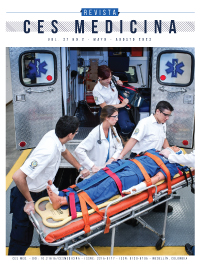Atypical presentation of Guillain Barré Syndrome in pediatrics. Case report
DOI:
https://doi.org/10.21615/cesmedicina.7162Keywords:
Guillain-Barre Syndrome, hypoglossal nerve, gait ataxia, asymmetric weakness, pediatricsAbstract
Atypical variants of Guillain Barré Syndrome (GBS) include asymmetric weakness and sensory symptoms, predominantly distal or proximal, diffuse pain or isolated involvement of cranial nerves prior to the onset of symptoms, irritability, meningismus and unsteady gait. Objective: to describe the following case of GBS with atypical presentation in a pediatric patient due to asymmetric weakness, gait disturbance, and unilateral involvement of the XII cranial nerve. Clinical Case: Afro-Colombian male adolescent, with left hemiparesis of distal onset, gait disturbance, ataxia, difficulty in lifting and left lateralization of the tongue. The diagnosis was supported by the study of cerebrospinal fluid with cytological albumin dissociation, magnetic resonance imaging showed enhancement of nerve roots and neuroconduction studies compatible with axonal-type polyneuropathy in the lower limbs. Conclusions: atypical presentations of GBS constitute a diagnostic challenge, the asymmetric weakness, and the compromise of the XII cranial nerve make it necessary to rule out other pathologies. Clinical history and physical examination supported by complementary studies of cerebrospinal fluid, neuroimaging and neuroconduction are useful to confirm GBS. Knowledge of the atypical variables of GBS in the pediatric population is essential for timely identification and early treatment.
Downloads
References
Lissauer T, et al. Neurological disorders. Illustrated Textbook of Paediatrics. Sixth Edition. Elsevier. 2022. Pag 502 -525.
Leonhard S, Mandarakas M, Gondim F, Bateman K, Ferreira M, Cornblath D, et al. Diagnosis and management of Guillain-Barré syndrome in ten steps. Nat Rev Neurol. 2019;15(11):671–83.
Yosha-Orpaz N, Aharoni S, Rabie M, Nevo Y. Atypical Clinical Presentations of Pediatric Acute Immune-Mediated Polyneuropathy. J Child Neurol 2019; 34: 268-276. DOI: 10.1177/0883073818825213.
Çifter G, Hoseinzadeh G, Issı ES, Algın Dİ, Erdinç OO. Twelfth cranial nerve involvement in guillain-barre syndrome: A case report. Turk Noroloji Derg. 2020;26(4):353–6.
Chung A, Deimling M. Guillain-Barré Syndrome. Pediatr Rev. 2018;39(1):53–4.
Gómez Á, Díaz A, Carrión-Penagos J, Reyes J, Reyes S. Clinical and electrophysiological characteristics of Guillain-Barré syndrome in Colombia. J Peripher Nerv Syst. 2019;24(3):268–71.
ClinicalKey. Guillain – Barré Syndrome. Clinical Overview. Elsevier. 2022.
Hao Y, Wang W, Jacobs BC, Qiao B, Chen M, Liu D, et al. Antecedent infections in Guillain-Barré syndrome: a single-center, prospective study. Ann Clin Transl Neurol 2019;6:2510–7.
Karalok ZS, Taskin BD, Yanginlar ZB, Gurkas E, Guven A, Degerliyurt A, et al. Guillain-Barré syndrome in children: subtypes and outcome. Childs Nerv Syst. 2018;34(11):2291–7.
Hu M, Li X, Wong HY, Feng XG, Wang YZ, Zhang GR. Asymmetric limb weakness in Guillain-Barré syndrome: Three case reports. World J Clin Cases 2022; 10(6): 1896-1902.
Deliceo Göbüt E, Us Ö, Işık U. Anti-GM2 antibody positive Guillain-Barré syndrome presenting with ataxia in a pediatric patient: An atypical manifestation. Brain Dev. 2021 Jun;43(6):729-733. doi: 10.1016/j.braindev.2021.02.003. Epub 2021 Mar 13. PMID: 33726944.
Katirji, Bashar. Disorders of Peripheral Nerves. Bradley and Daroff's Neurology in Clinical Practice. 2022, Elsevier. Cap 10. Pages 1853-1929.e14.
Morales-Galindo AL, Bolaños-Aparicio LF. Miller Fisher Syndrome: An uncommon Guillain Barré variant. Rev Mex Pediatr. 2021;88(4):149–51.
Sancho-Montero N, Fernández-Ramos JA, Caballero-Rodríguez C, Camino-León R, López-Laso E. Neuropatía craneal múltiple: descripción de tres pacientes pediátricos. Rev Neurol 2018;67 (08):321-323.
Asbury AK, Cornblath DR. Assessment of current diagnostic criteria for Guillain-Barré syndrome. Ann Neurol 1990;27 Suppl: S21-4.
Roodbol J, de Wit M-CY, van den Berg B, Kahlmann V, Drenthen J, Catsman-Berrevoets CE, et al. Diagnosis of Guillain–Barré syndrome in children and validation of the Brighton criteria. J Neurol. 2017;264(5):856–61.
Korinthenberg R, Sejvar JJ. The Brighton Collaboration case definition: Comparison in a retrospective and prospective cohort of children with Guillain-Barré syndrome. J Peripher Nerv Syst. 2020;25(4):344–9.
Downloads
Published
How to Cite
Issue
Section
License
Copyright (c) 2023 CES Medicina

This work is licensed under a Creative Commons Attribution-NonCommercial-ShareAlike 4.0 International License.
Derechos de reproducción (copyright)
Cada manuscrito se acompañará de una declaración en la que se especifique que los materiales son inéditos, que no han sido publicados anteriormente en formato impreso o electrónico y que no se presentarán a ningún otro medio antes de conocer la decisión de la revista. En todo caso, cualquier publicación anterior, sea en forma impresa o electrónica, deberá darse a conocer a la redacción por escrito.
Plagios, duplicaciones totales o parciales, traduccones del original a otro idioma son de responsabilidad exclusiva de los autores el envío.
Los autores adjuntarán una declaración firmada indicando que, si el manuscrito se acepta para su publicación, los derechos de reproducción son propiedad exclusiva de la Revista CES Medicina.
Se solicita a los autores que proporcionen la información completa acerca de cualquier beca o subvención recibida de una entidad comercial u otro grupo con intereses privados, u otro organismo, para costear parcial o totalmente el trabajo en que se basa el artículo.
Los autores tienen la responsabilidad de obtener los permisos necesarios para reproducir cualquier material protegido por derechos de reproducción. El manuscrito se acompañará de la carta original que otorgue ese permiso y en ella debe especificarse con exactitud el número del cuadro o figura o el texto exacto que se citará y cómo se usará, así como la referencia bibliográfica completa.
| Article metrics | |
|---|---|
| Abstract views | |
| Galley vies | |
| PDF Views | |
| HTML views | |
| Other views | |



